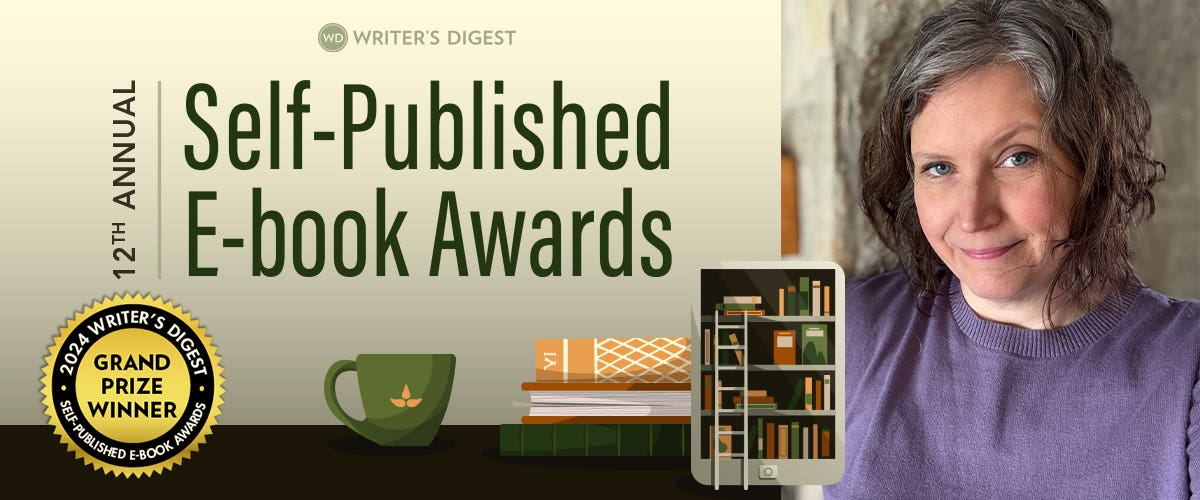7th Annual Pop Fiction Writing Competition Winner: Thriller/Suspense
Here’s the winning entry for the Thriller/Suspense category for the 7th Annual Writer’s Digest Popular Fiction Writing competition by emergency room physician Edward S. Wallace.
Here's the winning entry for the Thriller/Suspense category for the 7th Annual Writer's Digest Popular Fiction Writing competition by emergency room physician Edward S. Wallace.
A Journey in the Pit
People often ask what it’s like to be a doctor in the ER, what we affectionately call “The Pit.” They want to hear stories about the cool things I’ve seen and sometimes I’ll spin a tail about the guy who came in with a large kitchen knife sticking out of his chest, the handle quivering with every heartbeat. Or the gang-banger who came in with a gun shot wound, and the rival gang came into the trauma bay to finish him off. People like the bizarre stories too, like the woman who tried to kill herself by drinking gasoline, or the sky diver whose parachute didn’t open, but landed in a freshly-plowed field and survived. Yeah, the ER is rich with stories, but the one I think about most, the one that echoes in my mind over and over, is the one I never tell – the one about the night I met Charlene.
“Oh crap, not another ambulance,” I paused from dictating a chart as the paramedics rolled in. “What, are we the only hospital open tonight?”
“We like coming here ‘cause you guys have all the hot nurses,” the paramedic grinned.
“Can’t argue with that logic. What ya’ got there?”
“We think he’s a head bleed.”
I stood up to look over the counter at the intubated patient as he was wheeled by in the hall. I turned to my unit secretary, April. “So, I get a tubed head-bleed an hour-and-a-half before the end of my shift. Doesn’t the charge nurse want me to get out of here on time? I’m meeting some buddies at Maloney’s.”
“Want me to call neurosurgery?” April asked in her usual wry tone.
“I should probably examine him first. At least the history shouldn’t take too long with a gorked patient,” I half-smiled as I slung my stethoscope over my shoulder and walked around the desk.
After the paramedics moved the patient to the hospital gurney, I walked up to the foot of the bed. I broke a tongue depressor in two and ran the sharp end over the soles of the patient’s feet. “Nothing. Hey, did you guys paralyze him when you tubed him?”
“No. We didn’t give him anything at all.”
“Not getting much of a Babinski reflex.” I walked up to the head of the bed and shined a pen light in the patient’s eyes. “He’s got a blown right pupil. Was it that way on your initial exam?”
The paramedic walked up to the head of the bed and looked at the patient’s eyes. “No, doc. They were equal at 4 mm when I examined him.”
“He’s actively herniating. You guys are probably right about the head bleed.” I continued my cursory exam. “Is he on blood thinners?”
“Yeah, warfarin.”
“Great.” I poked my head out of the room. “Hey April, call CT, we need to put this guy on the table now. And call blood bank, we need a couple of units of FFP up here ASAP.”
I turned to the two nurses in the room. “Start mannitol, 50 g IV push. We need basic labs and coags.” Megan and Jen were good to work with. Megan had been a nurse for twenty-one years and was what I would call well-seasoned. I didn’t have to worry about her doing something stupid. Nurses like Megan really made a shift go easier. Jen, on the other hand, although easy on the eyes, was green, really green - she had just graduated two months prior. In her first week in the ER, she had to put a Foley catheter in a patient to drain his urine. Usually not too hard to do, but it was Jen’s first time. One of the older nurses had told her it’s a lot easier to pass the catheter through the penis if the patient has an erection. This, of course isn’t true, but Jen didn’t know that. She had been in the room for a while when the other nurses went in and found her giving the guy a hand-job while trying to place the catheter. Apparently, the expression on the patient’s face was some combination of bewilderment and absolute pleasure. She will never live that one down.
I walked back out of the room and sat down at my desk to resume my dictation. I looked at April. “On the bright side, at least we know the disposition of the new patient. I should be able to finish this in the next hour and get out of here on time.”
April nodded then covered her mouth. “Charge nurse, twelve o’clock.”
I sighed, “I wonder what she wants.”
“Probably to give you another patient.”
I looked at April over my glasses and growled.
“Hey doc. How are you doing?” the charge nurse said.
“Alright, but this new guy is probably a head bleed. He’s got a blown pupil. He’s down in CT right now.”
“I’ll order a unit bed. Can you take another one?”
“I leave in about an hour, and I’ve got plans afterwards. Can you give it to someone else?”
“The other two zones are pretty busy. The patient is just a 25 year old female with anxiety. She’s hyperventilating out in triage and stirring up the other patients. I want to get her out of the waiting room.”
“Anxiety? That’s it?”
“Looks pretty simple, lorazepam and ship her to psych.”
“Alright, I’ll do it, but that’s it. My zone is now closed.”
“Thanks, doc.” She smiled and winked at me. I always hated patronizing winks.
“OK, April. I’m going to finish this dictation now. Have Jen start this new patient in room 7. Megan is down at CT with the head bleed.”
I finished up the rest of my charts and got the head-bleed patient admitted to the unit. I had things lined up for an on-time departure. It was 9:45 pm and I only had one thing left to do – see the anxiety patient.
I picked up the chart and walked into room 7. “Hello there, I’m Doctor…”
“I can’t breathe,” the patient interrupted me. “I can’t… get… air,” she panted inbetween words.
“Charlene Deangelo,” I read aloud from the chart. “Is that your name?”
“Yes,” she whispered.
“I need to get a little history to help you out. When did your shortness of breath start?”
“About an hour ago,” she again panted.
“Listen, if you don’t slow your breathing, you’re going to...” She pulled her arm back from Jen, who was trying to wrap a blood pressure cuff around it. “Listen, you need to slow down your breathing… You’re hyperventilating. We can’t help you if you don’t let us…” I sighed and turned to Jen. “Give her a milligram of lorazepam and let me know when she’s settled down enough to talk to.” As I walked out of the room, I turned back and added, “And please get some vitals. It looks like they didn’t get any in triage. I can’t imagine why.”
Jen smiled back and rolled her eyes.
Well, this threw a wrench into things. I couldn’t finish this patient until I calmed her ass down with lorazepam, at least enough to get a history. I tossed the chart on the desk and walked back to the galley to get a cup of joe.
One of my colleagues was also there getting a caffeine bolus, “Hey Mike.”
“Hey, aren’t you about out of here?”
“Just got an anxiety patient that’s hyperventilating so much I can’t get a history. I’m hitting her with lorazepam before I go back in.”
“Just put a bag over her head and she’ll settle down. It works with birds.”
“Not a bad idea,” I chuckled and filled a cup with fresh coffee.
When I got back to my desk, I checked the chart for the vital signs. “Blood pressure 132/82, pulse 138, respiratory rate 35, probably still anxious,” I muttered to myself. “Oxygen saturations 82%, uh, oh.”
I grabbed my stethoscope and walked back into the room. “Ms. Deangelo?”
“Please, call me Charlene.”
“OK, Charlene, how are you feeling now?”
“I feel a lot less anxious.”
She looked a lot better, but still short of breath. She was actually pleasant to talk to when she wasn’t hyperventilating. She reminded me of a young mother with long, auburn-colored hair and hazel eyes. She wasn’t wearing any makeup or lipstick, but didn’t need any. A simple silver locket was her only jewelry.
“Your oxygen saturations are quite low. Do you have any prior problems with your lungs?” I asked her.
“No.”
“Do you take medications for anything?”
“No.”
“Hmm, so, tell me more about the shortness of breath.”
“Well, like I said, it started suddenly about an hour ago while I was watching TV, like being hit by a ton of bricks. And the pain…”
“You’re having chest pain?”
“Yes, it’s sharp and stabbing. Its right here,” she pointed to her right upper chest. “It hurts to take a breath.”
“Have you ever had a blood clot, Charlene?”
“No, but my sister had them in her legs. She has to take a blood thinner.”
“Warfarin?”
“Yes, that sounds right.”
“Do either one of your parents have blood clots?”
“I never knew my dad. My mother died when I was in high school. I don’t know why. They said she just suddenly dropped dead.”
“Hmm.” I placed my stethoscope on her back. Her lungs were clear, but it was obviously hurting her to take each breath. “Charlene, I’m concerned you may have a blood clot. It usually start in the legs, then breaks off and goes to the lung. We call it a PE or pulmonary embolus. We need to get a CT scan of your chest to find out.”
“You’re scaring me. You think I have a blood clot?”
“Yes.” I touched her shoulder. Her skin was soft. I could feel her breathing slow a little. “But you’re going to be OK. A PE is treatable.”
She sighed and looked up at me with glassy eyes. “Thank you.”
When I sat back down at my desk, April was already starting in on me. “Well, doctor, its five minutes past ten, and you’re still here.”
“Bite me.” I sighed and started entering the orders in the computer.
“Should I call psych?”
“No.” I turned to face her. “It’s not anxiety. Don’t get me wrong, the girl is anxious, but I think she has reason to be. She’s probably a PE.”
“That’s not a good end-of-shift patient. Why don’t you turn her over to one of the docs in the blue zone and get out of here?”
“Oh, it shouldn’t be too long. I’ll just wait for the CT, then I can start her on heparin and admit her. I should be out of here by eleven. Maloney’s is five minutes from here. The other guys probably aren’t even there yet.”
I checked back with Charlene a half-an-hour later. “You doing OK?”
“Yes. The pain is better, but I still feel short of breath.”
I checked her oxygen. She was on one liter so I bumped it up to two. “There, that should help.”
“My nose has been running and I don’t know why.”
I handed her a box of tissues. “If you’ve been tearing up, the tears drain from your eyes into your nose. That’s why we always have a runny nose when we cry.”
“Thank you.” She very gently blew her nose and sniffled a bit. She clenched the tissue in her hand and looked down. “Do you think my mother died from a PE?”
I paused and bit my lip. I sat down on the stool next to the bed and touched her arm. “I don’t know for sure, but with a possible family history of a blood clotting problem, a sudden death like that is very suspicious for a PE.”
“And that could happen to me?”
I thought yes, but answered differently. “If we see a PE on the CT scan, we can treat it with blood thinners.” I glanced up at the figure in the doorway. “They’re here to take you to CT. I’ll see you when you get back.”
She looked up at me and mouthed the words, “Thank you.”
When I got back to my desk I pulled out my iPhone and texted my friend Eric. Running late. Will be there in 30 min. You there yet?
The reply came back a couple of minutes later. Get your butt down here. On second pitcher. I looked over at April. “The guys are already there.”
“I told you that you should have turned her over to the blue zone doc. You’d better hurry or they’re going to run out of beer.”
I half-sneered at her. “Maybe you should start the admission process. With oxygen sats like that she’ll definitely be staying the night with us.”
“I thought you’d never ask.”
About 15 minutes later, the phone rang. April said “Uh, oh,” as she looked at the screen.
“Uh oh, what…”
“The phone, it’s the radiologist.”
In the ER, the radiologists don’t call to see if you want to go out for beer after a shift. They don’t call to talk politics, or because they’re bored. The call for one reason and one reason only, badness.April transferred the call to my phone. The plastic handset felt like a cold, heavy piece of metal as I lifted it to my ear.
“Hey, it’s Miller over in the reading room. That patient you got the CT Angiogram on, Deangelo.”
“Yes?”
“Big PE, I mean big. The whole right upper and most of the right middle lobes are involved and it extends to the pulmonary bifurcation. It’s a saddle.”
“Oh, boy, this is going to be trouble.”
“Is she short of breath?”
“Yeah, and her sats are in the 80’s.”
“I don’t envy you tonight. Good luck.”
“Thanks.” I hung up the phone and looked at April. “She’s got a saddle PE. This is not good.”
“You want me to call pulmonary?”
“Yes, I’ll be in the room.” I walked back to room seven just as they were hooking Charlene back up to the monitor. I grabbed Jen by the arm and whispered in her ear. “Draw up 100 mg of alteplase. We’re going to have to lyse her.”
Jen looked back at me like a deer in the headlights. “I’ve never…”
“Get Megan, she should be back from getting the head bleed to the unit by now. She’ll show you how to set it up.”
She hesitated and looked back at me.
“Now!”
Charlene looked up at me, duplicating Jen’s look. “What is it?”
I sighed and sat down on the stool. They always taught us in med school that if you sit down when you talk to a patient, it shows more compassion. They think you were there longer and have a better impression of the doctor. I always thought it was a load of crap and a waste of time. This time, I wasn’t doing it for the patient, I was doing it for me.
“What did you find out?”
“The radiologist just called me. You have a PE.”
“OK, you told me that’s what you thought it was. You said it was treatable, right? You said you could treat it… that I’d be OK, right?”
“This is a bigger PE than I originally thought. It lies at the pulmonary bifurcation. It’s what we call a saddle PE. They’re very dangerous because they can block the blood flow to both lungs at once.”
“You mean, I could die?”
I gently touched her forearm and she immediately pulled away. “Listen, it’s still treatable, it’s just that we have to use more aggressive treatment. We have to give you thrombolytic or ‘clot busting’ drug that breaks up the PE.”
“OK…” she grabbed my hand. “And…?”
“It’s a dangerous medication. It doesn’t just break up the PE, it dissolves all blood clots in your body. It can lead to life-threatening bleeding. You could bleed in your gut, your chest, your brain…”
“Do I have any other options?”
“A thrombolytic is considered first line treatment for a big PE like this. Clot retrieval is another option – surgery to remove the clot, but that’s not usually done unless the thrombolytic fails.”
“I don’t want to die.”
“Nobody said you’re going to die. I’m just… I’m just trying to help you understand what’s going on.”
She grabbed the silver locket draped over the curve of her neck and opened it. “This is my little girl.”
We sat there for the next ten minutes. She told me about dress up and tea parties. About what it was like to be a single mother of a three-year-old. Then, her hand dropped to her side. I looked up to her face. Her eyes were staring into space and her mouth was slightly open. I felt for the carotid pulse in her neck. Oh, God. I hit the code button on the wall.
We see death in the emergency room all the time. You become immune to it. Most patients who die come in unconscious, and they never come back. Death is just what happens. When someone comes in talking to you, however, and then dies, it’s a different thing, a very different thing.
I started chest compressions and within a minute or so, the room was filled with people. “Someone else take over the compressions, I’m going to tube her.”
I made my way to the head of the bed and grabbed the laryngoscope. “Get me a 7.0 cuffed tube, she’s petite.” I’ve always been comfortable with airways. Intubation is bread and butter for an ER doc. The fact that she was talking to me a few moments earlier, however, made this seem… odd.
“You all right, doc?” Megan asked.
“Yeah, yeah, I’m all right. I lifted Charlene’s jaw and inserted the laryngoscope. Her vocal cords came in to view. “Tube.” The endotracheal tube was slapped in my open palm. I inserted it through the cords. “Give me a couple of breaths.” I said to the respiratory tech. “OK, fix it there.”
I walked to the foot of the bed and touched Charlene’s foot. It was warm. I called out of the room to April, “Get me a STAT chest x-ray, please, and call cardiothoracic surgery. See if they’re available for clot retrieval.”
I focused my attention back to the room. “Hold your compressions. Do we have a pulse?”
“I think I’ve got a faint one,” the respiratory tech said.
I placed my fingertips over her carotid artery. “Yes, there’s a thready one.” I turned to Megan. “You have the thrombolytic?”
“Yes, you want to give it?”
“We have to. She has a known saddle PE and she just arrested. If we don’t, she’ll die.”
“Hey, doc, Pulmonary is on line 3,” April shouted from the desk.
I walked out of the room and picked up the phone, “Hey, Alex.”
“What do you have down there.”
“A twenty-five year old female with a saddle PE. It extends to the right upper and right middle lobes.”
“Have you gotten an echo to see if she needs thrombolysis?”
“No, she just arrested, so I gave the thrombolytic.”
“You have a pulse back?”
“Yes, but its thready. I’ve got a call out to cardiothoracic surgery to see if they can do a clot retrieval.”
“Is she intubated?”
“Yes, I tubed her when she coded.”
“Well, it looks like you’ve done everything that can be done at this point. I’ve got a unit bed for her. I’ll be down to see her in a few minutes.”
“Thanks, Alex.”
I walked back into the room. “How is she?”
“Stable pulse,” Megan responded.
I walked up to the bed and touched her forehead. As I did, my iPhone started buzzing on my hip. I looked at the text. Hey, are you joining us?
I was about to text back when she arrested again.
“Hey, doc, I lost the pulse,” the respiratory tech barked.
I felt for the absent carotid pulse again and shook my head. “Start compressions and give her an amp of epi.” I poked my head out of the room again. “April, has cardiothoracic surgery called back?”
“They said they just started a case and are in the middle of putting a patient on the heart-lung bypass machine.”
“Call into the OR, I need to talk to the surgeon.”
April shook her head and dialed. Thirty seconds later she held up the phone to me. “They have you on speakerphone with the surgeon.”
“Hey, Carl, I’ve got a 25 year old female down in the ER with a saddle PE. We’ve started thrombolysis, but she’s arrested twice. Can you guys attempt a clot retrieval?”
“I’m sorry, we’ve just started the heart-lung bypass protocol. I can’t leave the OR right now. I can call in my partner, Dr. Patel, but he’s probably at least 45 minutes to an hour out.”
“That’s too long. She’ll die.”
“I can’t abandon this patient right now. I’ll call Patel.”
“Just tell him to get here as fast as he can.” I slammed the handset down and walked back into the room.
“Hold compressions.” I felt for the carotid pulse. “Nothing; resume compressions.” I turned to Megan, “How much of the thrombolytic has gone in?’
“About a quarter of it; we can’t go any faster.”
I bit my lip, “Give her another dose of epi.”
Alex, the pulmonary critical care doc walked in. “Need any help?”
“We’re stuck between a rock and a hard place. We’ve got the thrombolytic going. This is her second arrest.”
“You talk to cardiothoracic surgery?”
“Yeah, but they’ve just started a patient on the bypass machine and can’t come down. Patel is on backup and is on his way in, but is about 45 minutes out.”
“There’s nothing else you can do.”
“I know.” I took a deep breath. “She came in talking... she was talking to me.” I touched her foot again. It was cold.
“We’re not getting any perfusion here, make sure those compressions are full...”
We had been doing chest compressions for an hour when Patel finally arrived. When he walked into the room, he shook his head. “You’ve had no pulse for over an hour?” He felt her feet and hands. “Poor perfusion. Does she have any signs of being neurologically intact?”
I hesitated, “No. Pupils are fixed at 7mm. No response to painful stimuli.”
Patel put his hand on my shoulder. “I drove as fast as I could. I’m sorry I couldn’t get here faster. But… a clot retrieval isn’t going to save her. She’s gone.”
Alex was standing in the corner and walked over to me. “He’s right. There’s nothing else you can do.”
I took a deep breath and walked over to the head of the bed. I reached out and touched Charlene’s forehead. It was cold. Her skin was bluish all over. Her hazel eyes were fixed in a stare to nowhere. I gently lowered her lids and looked up at the clock, “Hold your compressions.” I felt for her absent carotid pulse one last time and exhaled slowly. “Time of death: 11:52 pm.”
As everyone filed out of the room, I opened the silver locket and looked at the picture of the little girl who was going to grow up without a mother. My iPhone buzzed at my hip. I looked at the text. Where are you? I threw it against the wall. The case split in two as it bounced to the floor in pieces.








